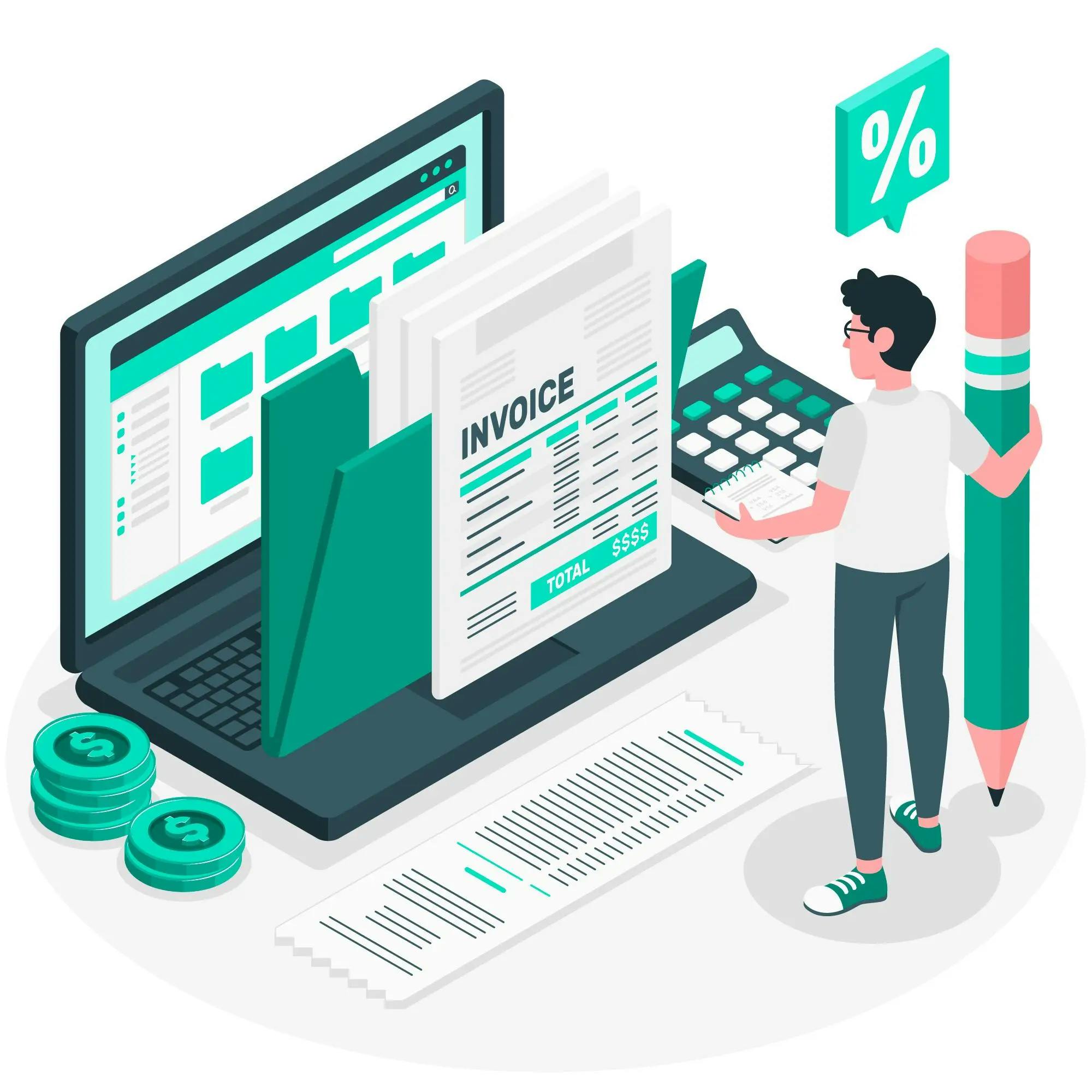E-Invoicing 101: A Beginner’s Guide

The importance of E-invoicing has been increasing significantly in recent years, although it is not a new technology. Be it SMEs or big corporations, digital invoicing has paved the way to becoming the today and tomorrow of invoicing.
The government of India declared the fifth phase of mandatory implementation of E-invoicing for businesses with an annual turnover exceeding Rs. 10 Crore from 1st October 2022. The sixth phase for businesses with an annual turnover exceeding Rs. 5 Crore which was set to be implemented from 1st January 2023 to be is yet to be notified.
So, gone are the days when businesses mailed PDFs or dealt with traditional paper invoices, The ever-growing adoption of electronic invoicing is not only a choice anymore but a need. A very crucial and important need of every business which has to remain compliant with the statutory requirements.
According to a recently published report, Billentis estimates that the size of the global e-invoicing and enablement market will reach approximately EUR 18 billion (USD 20.5 billion) in 2025. They also stated that the use of electronic invoicing is estimated to grow by 11% this year in the B2B2G area.
So, here is a beginner's guide on all you need to know about electronic invoicing and the benefits it offers:
What are E-invoicing and E-invoice under GST?
E-invoicing, also known as electronic invoicing or electronic billing, is the transmission, reception, and process in which invoices are transmitted electronically between a supplier and a buyer with the government network and systems playing the role of the control point as well as the relaying authority. It is a GST-compliant electronic authentication method verified by the Goods and Services Tax Network (GSTN).
This system ensures that a common format is followed by all businesses before reporting invoices to the GST portal. According to the process, a business must register all B2B and export invoices it generates with the government system, the Invoice Registration Portal (IRP), and acquire an individual identification number for each invoice called an Invoice Reference Number (IRN). Along with the IRN, the IRP will also digitally sign the provided invoice data and create a QR code using a few details from the invoice.
So an electronic invoice is a printed document with a digitally signed QR code and an accompanying IRN.
The government made an electronic invoice template available to the public in August 2019. The GST Council then made changes to the document to make it consistent with their rules. The common format not only makes compliance simpler but is used by all industries ensuring that compatibility between GST ecosystems is guaranteed.
How does E-invoicing work?
Electronic invoicing makes it easier to manage invoices and compliance documentation. It lowers the possibility of invoice errors and exclusions by digitising invoice data and cross-referencing it with contracts, customer orders, service entry sheets, and product receipts.
The GST Portal and e-Way Bill are the two systems that need to be produced and notified when a seller-generated invoice is received. Businesses produce invoices using a variety of software, and the taxpayer enters the invoice information using a relevant API in a GSTR-1 return. A GSTR-2A contains the same information and makes it available to receivers with "see only" permission. Hence, businesses must immediately create the e-Way Bill, either electronically or by manually inputting the invoices into their respective accounting software.
Notably, e-invoicing is becoming an absolute necessity day by day as the Government of India has mandated its implementation.
How to Generate an E-invoice Under GST
It is the taxpayer's or the company's responsibility to create the invoice(s) and submit it to the Invoice Registration Portal (IRP) for authorization. The portal will send the invoice back to the provider after apt confirmation along with a special reference number, a digital signature, and a QR code.
Step 1: Create an invoice
The seller or supplier will use his or her accounting or billing software to create an invoice in the required format (e-invoice schema). It must provide the necessary information.
Each B2B invoice will be produced by the supplier's accounting software as a JSON file. The JSON file will be added to the IRP.
Step 2: Creation of IRN
The seller would then use a typical hash-generation procedure to generate a unique Invoice Reference Number (IRN).
Step 3: Uploading the invoice
Now, either directly or through third-party software, the seller will upload JSON for each of the invoices as well as IRN to the Invoice Registration Portal.
Step 4: Verification and Signature
If the provider hasn't previously uploaded an IRN, IRP will produce one or check the hash/IRN attached with JSON. Then, it will check the file's authenticity against the GST central registry. It will add a QR code to JSON and its signature to the invoice following successful verification. The previously created hash will serve as the new IRN for the E-invoice. For the duration of the financial year, it will serve as the specific identification of that electronic invoice.
Step 5: Data Sharing
The E-way bill and GST systems will both have access to the uploaded data.
Step 6: Downloading the E-invoice
The seller will receive a return message from the portal that includes the digitally signed JSON, IRN, and QR code.

What are the Benefits SMEs can receive from implementing an E-invoicing system?
- Unified process:
Electronic invoicing makes it possible to manage all accounts payable information and processes from a single dashboard. Business users access, integrate, and summarise data across various systems and devices without difficulty, so there is no content duplication.
- Increased efficiency:
E-invoicing enables SMEs to produce, transmit, and receive invoices digitally, which can speed up the process and lower the possibility of mistakes. Due to enhanced visibility and end-to-end tracking, you can guarantee correctness. The verification, approval, and payment of invoices can all be followed in real-time. This considerably lowers the errors and problems, ensuring that there are no longer any accuracy problems that result in overpayments and duplicate payments. Therefore, digital invoicing is crucial for creating a closed audit trail to make tracking and payment easier.
- Reduced costs:
Using electronic invoicing can save SMEs money on paper invoice printing and shipping. Effective tracking of every penny spent and saved is made possible. In essence, this aids in the monitoring and reporting of actionable strategies on cost centres and finds ways for greater cost savings, such as early payment discounts. Thus, the data at hand facilitates better and more knowledgeable decision-making, saving both time and resources.
- Enhanced security with better visibility:
E-invoicing can lower the possibility of fraud and unauthorised access to private financial information. It specifically enhances visibility into invoices, purchase orders, supporting documents, and agreements and provides comprehensive audit trails and tracks invoices.
- Increased Compliance:
A system for electronic invoicing is more than simply a location to store digital invoices. E-invoicing makes it simple to achieve a greater degree of compliance. It is very important for regulatory compliance. The Input Tax Credit ( ITC) can be further guaranteed in case of E-invoicing as the data can be automatically populated to GSTR-1 of the seller for the respective month in which the e-invoice has been generated. This helps reduce the significant compliance burden on account of reconciliations and follow-up.
How to Implement E-invoicing in your Business?
- Inform Clients of Your Plans
Whenever you decide/are statutorily required to generate e-invoices, you must inform your clients of the same. Encourage them to use an automated invoicing platform because it might be advantageous for both sides. Benefits could include enhanced organizational performance, increased productivity, a seamless billing cycle, faster ITC reconciliations, etc.
- Integrate E-invoicing Standards with Your ERP System
In reality, your top priority should be integrating digital invoicing standards into your current ERP systems. If you own software that is incompatible with integrating an automated e-invoicing process, consider switching to an automated cloud-based one, like GenieBooks. Although it is highly unlikely, if you haven't already begun, it is advised that you move quickly to integrate electronic invoicing into your ERP system. The government-approved GSP (GST Service Provider) can also help you acquire API integration.
- Locate Vendors for ERP System Reorientation
There is a chance that your current ERP system won't work with e-invoicing. You should check with your current seller to make sure of this. Find a new provider to orient your ERP software as soon as possible if you are having technical glitches. Make sure they have experience and a thorough understanding of GST requirements in India before appointing one. These providers offer quick updates, effective reconfiguration of your current ERP or the implementation of new ones, as well as assistance for the duration of your business journey.
Takeaway
One of the most important initiatives businesses are taking to digitise processing cycles is the use of electronic invoicing. Notably, governments all over the world, particularly in Asia, have introduced mandates and are working to establish frameworks to enable e-Invoicing.
The only thing left to do is deploy your electronic invoicing system and evaluate its effectiveness. If you haven't already, now is the moment to invest and give your business the best digital transformation it needs.